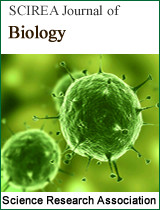Horticultural capture patterns of two fruit moth species in traps variously baited with both pheromones
DOI: 10.54647/biology180365 59 Downloads 16789 Views
Author(s)
Abstract
Specificity of synthetic pheromone lures to trap plum and apple moth males is standard agricultural practice to predict timely application of insecticides to fruit trees. Compatibility of both lures in the same trap has long been accepted for capture of both in several two-moth combinations, but any specificity for their relative positioning in a trap has remained untested. Experimentally-distanced lures in a trap during a month of fruit moth activity in an English horticultural context in 2000 resulted in apparently random capture but with some pattern distortion. However, in subsequent years, when lures were deliberately distanced diagonally across the trap surface, a distorted capture pattern involving avoidance of males from their corresponding female’s pheromone suggested some disturbance in olfactory sensory perception and flying response within the trap. Further application of identifying individual captured moth carcases as of plum or apple moth by dissection of abdominal genitalia apparently revealed measurable disinclination to land near their corresponding female’s pheromone. Another experiment confirmed that two adjacent lures did not disturb normal moth flying within the trap, but distanced positions caused statistically-disturbed flight patterns. The report encourages further experimental testing of male moth targeting towards, or subtle confusion by, pheromone lure location in traps for both Grapholita funebrana and Cydia pomonella in horticultural settings, to define optimum distancing of lures for maximum response and to appreciate their function in fruit moth sensory capacity. Further study could extend to the other pairs of moths, claimed a third of a century ago to be trapped by both lures in the same trap. Male fruit moth sensory perception may be more complex than generally assumed.
Keywords
pheromone; Cydia pomonella; Cydia funebrana (Grapholita funebrana): plum moth; apple (Codling) moth; olfactory physiology; genital dissection
Cite this paper
Peter Mantle,
Horticultural capture patterns of two fruit moth species in traps variously baited with both pheromones
, SCIREA Journal of Biology.
Volume 9, Issue 1, February 2024 | PP. 1-12.
10.54647/biology180365
References
| [ 1 ] | Alford, D.V. Observations on the specificity of pheromone-baited traps for Cydia funebrana (Treitschke) (Lepidoptera; Tortricidae). Bulletin of Entomological Research 1978, 68, 97-103. |
| [ 2 ] | Schwalbe, C., Mastro, V. Multispecific trapping techniques for exotic-pest detection. Agriculture, Ecosystems and Environment 1988, 21, 43-51. |
| [ 3 ] | Rothschild, G.H.L. Control of the oriental fruit moth Cydia molesta (Busck) (Lepidoptera Tortricidae) with synthetic female pheromone. Bulletin of Entomological Research 1975, 65, 473-490. |
| [ 4 ] | Odinokov, V., Ishmuratov, G., Balezina, G., Tolstikov, G. Insect pheromones and their analogs. XIII. Synthesis of DODEC-8E-ENYL and DODEC-8Z-ENYL acetates - components of the sex pheromones of Grapholita funebrana and Grapholita molesta. Chemistry of Natural Compounds 1985, 21, 372- 374. |
| [ 5 ] | Gilligan, T.M., Epstein, M.C. TortAI, Tortricids of Agricultural Importance to the United States (Lepidoptera: Tortricidae), 2014. idtools.org/id/leps/tortai/Grapholita_funebrana.htm |
| [ 6 ] | Venette, R.C., Davis, E.E., DaCosta, M., Heisler, H., Larson, M. Mini risk assessment, Plum fruit moth, Cydia funebrana (Treitschke) [Lepidoptera: Tortricidae], 2003, http://download.ceris.purdue.edu/file/1475 |
| [ 7 ] | Chen, M. H., Dorn, S. Reliable and efficient discrimination of four internal fruit-feeding Cydia and Grapholita species (Lepidoptera: Tortricidae) by polymerase chain reaction-restriction fragment length polymorphism. Journal of Economic Entomology 2009, 102, 2209-2216. |

